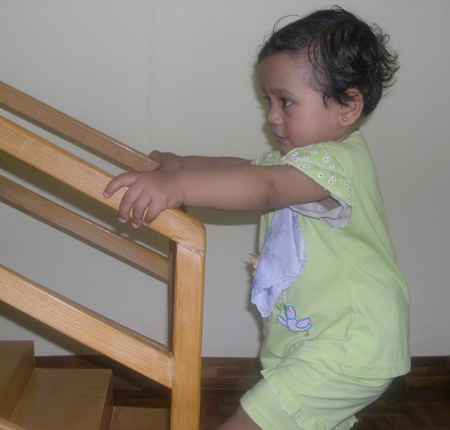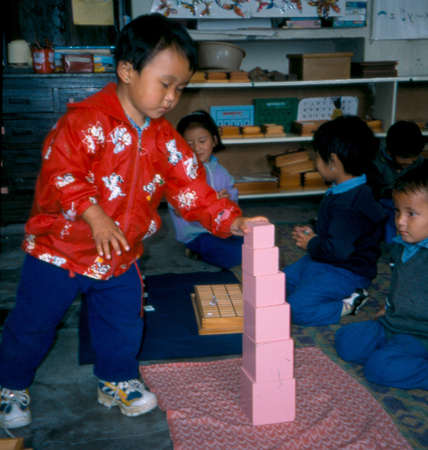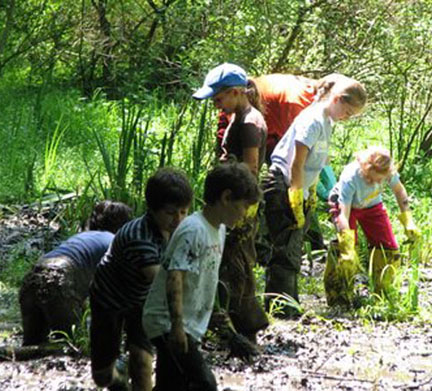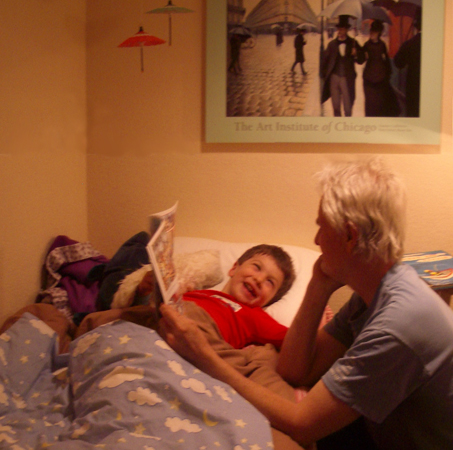PARENTING/TEACHING, Birth-3
Parents, The Child's First Teachers
Geographically removed from family and the wisdom of elders, isolated from neighbors, tantalized by glamorized ads for "necessary" products, many couples need help in returning to healthy, solid parenting. Great strides have been made in preparing parents for a more natural childbirth, and in alerting them to the importance of breast feeding, but parents need much more information about the first hours, days, months and years of the life of a child. It is now common knowledge that the first three years have the greatest influence on the entire life of a person, not only physically, but emotionally and psychologically. That is where this information can help.
Physical safety and a healthy diet are essential in raising healthy children. But just as important is the creation of an environment that will provide calm and gentleness, love and security, that will foster physical, mental, emotional, and social development, a positive self-image, and joy.
A Sense of Order
In the first three years of life children have a very strong sense of order—of both place and of time. An infant can become very upset over things that we would not notice or think of as upsetting; for example the child who cried because an umbrella, which he had seen many times closed, was opened for the first time. Or a child being upset by a change in temporal order by being bathed after a meal when she has become accustomed to being bathed before a meal.
The young child is constantly trying to make sense of the real world, to create order, to create himself in relation to it. When the child figures out where everything belongs and how the day goes, he develops a feeling of security.
A child has his own inborn natural rhythms, or knowledge of when to go to sleep and when to wake up, when to eat, what to eat, and how much. If the parent can take time in the beginning to observe the child, to learn and respect the inner guides—for example trying to never wake a sleeping child, or allowing him to nurse until he wants to stop—life will settle into a routine more quickly.

( Montessori Infant Community in Nepal )
The Changing Environment
The child thrives when he has the secure knowledge that the environment, objects and schedules, will remain the same. But at the same time, as the child grows and changes, the environment must change, gradually and subtly, to reflect his changing needs. The child constantly grows in independence and responsibility, and the adults must strike a balance between offering to help, and holding back when the child can do for himself. An important saying is, Every unnecessary help is a hindrance to development.
Parents who learn to observe their children will be able to tell if a toy is still appropriate, or if furniture is still of the correct size for their growing child. They will recognize when the child is ready to use a spoon or glass, remove or put on her own clothing, cut his own food. Each new skill is a step toward participation in family life.
The Parents’ Needs
Parents do the best with the knowledge they have at the moment. No matter how much we all try to be perfect we must learn to be easy on ourselves, to not waste time wishing we "had only known," to learn to laugh, pick up the pieces, begin again.
What a pleasure it is for parents to slow down their own lives and match the child's speed, share the cooking, the making of gifts, holiday baking, sewing and knitting, gardening, making valentines, laundry, fixing and oiling furniture, arranging flowers, building and cleaning, and so forth. Life becomes richer and more loving. The most important gift we can give our children is our time.
Modeling , Setting Limits, and Time Out
The child does not just observe her surroundings, she becomes them by age three. In the first year the infant is absorbing the language, tone of voice, interactions, joy, and interests of the family.
If you want your child to say "thank you" and "please" you must be using this language constantly in her presence from birth on. Children who are spanked learn to use physical punishment to express themselves, and those who are handled with understanding and patience will become understanding and patient.
When a limit must be set, like not touching the stove or not running into the street, the parent should physically, gently remove the child so he knows that "Don't touch" or "Stay out of the street" really means "move away from that object." Or "Move out of the street." That way the parent will not have to repeat, the child will have no opportunity to disobey and the lesson to obey will be learned.
This requires absolute consistency on the adults' part in the beginning but it is very worth the effort.
When a "time out" is necessary because nothing else is working, be sure to treat the child as you would like to be treated. For example you are at a party with friends and you are exhausted and tired and hungry and you lose it and say something rude to your spouse. How do you want him or her to treat you?
Would you prefer "Get out of this room immediately!" or perhaps "Say you are sorry and say it like you mean it!" Or "Could I please speak to you in private for a moment" and then "Something must be very wrong for you to get this upset, shall we go home so you can rest?"
When a child needs time out he should have already seen adults cherish private time or time alone (time out) to recover or perhaps to rest or work. Then this experience can be offered to the child in the same spirit and not as punishment.
Her is a conversation between our daughter and our 4-year-old granddaughter:
Z: Mama, I need to tell you something.
N: Okay.
Z: When I do something wrong and you yell at me, well, that doesn't really help. It just doesn't. It just makes me really mad. (Pause, and she continues) so what I think you should do is just tell me. And be really really polite.
N: Well, that's probably true. But usually when I yell at you it's because you're behaving very badly, and you don't always listen when you're like that.
Z: . . .Well . . . . Well, you could TRY being really polite ONE time, and then yell only if it doesn't work.
Educational Materials for 0-3
A sparse environment of carefully chosen materials supports this development, and a crowded or chaotic environment can cause stress. Natural materials are always safer and more pleasing than plastic. The toys and materials in the home and school should be of the very best quality to invite the child to use them, to call forth self-respect and respect and care toward the environment, and to foster appreciation of beauty.
We are very cautious about allowing children to be guinea pigs for the use of new inventions such as walkers, swings, certain baby carriers, pacifiers, computers and televisions. Research supports the benefits of this healthy attitude to the child's
Uninterrupted periods of concentration on play or work that involves both body movement and mental intention toward a goal, fulfill the needs for order, movement, work, repetition, perfection, concentration, exactness, imitation, independence, and self-control.
Conclusion
Using the ideas in The Joyful Child has been compared to making sure that the soil in an organic garden has everything necessary for the optimum growth of a plant—and then stepping back to see the unfolding of the perfect plant. The Joyful Child has been compared to "a health store manual for the body and mind." The text in these pages gives a short introduction to the Montessori Birth to Three, or Assistants to Infancy practices. We hope you are inspired to learn more.
|
PARENTING/TEACHING,
Age 3-12
I never teach my pupils;
I only attempt to provide the conditions in which they can learn.
— Albert Einstein
Parenting / Teaching
Through our children, we parents and teachers are the architects of the future of humanity. As we go about our daily lives in the presence of children we are constantly teaching by our own words, thoughts, and behavior.
Education is sometimes narrowly defined as the teaching of math, language, sciences and the arts, but the most important subjects to be mastered are: how to be happy, to be a compassionate friend, to express care through thoughtfulness and good manners, to identify a problem and work hard to solve it, to know how to be happy.
More than facts, we must help our children develop a love of learning, an ability to make intelligent and responsible choices, to concentrate and focus, and to do one's best to complete a task to the satisfaction of oneself rather than to please someone else.
Concentration & Contemplation
It was the great discovery of Dr. Montessori that after completing a prolonged period of deep concentration and contemplation, a child often expressed a great joy and a desire to help others. Perhaps this is what adults who daily make time for prayer or meditation feel, and why we think of them as happier, more peaceful, and in some ways better human beings than those of us who just rush from one task to the next.
Lessons on morality, books on morality, gold stars, these exterior inducements to happiness and goodness are never as successful as a good night’s sleep or a long period of concentrated work or contemplation during which the mind can process the day’s input, solve problems at a deep level, and come out happy.
The most important advice on parenting and teaching we can offer is to constantly watch for periods of concentration and contemplation in our children and protect these moments from interruption.
A Fresh Look. One of the most important attitudes to nurture is to see each child as a new being each day, forgetting the past and seeing only the potential for greatness.
This is also the best way to look at ourselves. It is a lot to ask of the adult to provide everything a child needs, and we believe that some time should be allotted, perhaps at the beginning of each day, to getting mentally prepared for the task by taking a walk, meditating, praying, etc. Then one is better able to take a deep breath and face the day with a feeling of being new and in the present moment. If we can balance ourselves, our interactions with our children will be more enjoyable.

( Montessori 3-6 class, Tibetan Children's Village, India)
AGE 3-6, the House of Children, not a school
The 3-6 environment is called a Casa dei Bambini, or House of Children because it is very different from the traditional preschool. To imagine the difference think of how you act when welcoming friends into your own inviting, comfortable, enjoyable home.
Would you have everyone, all of your guests in your home, sit still on a line and put their hands in their lap and close their mouths? Or would you have specially prepared interesting activities, perhaps some food, and welcome each person with a personal greeting, inviting her to make herself at home? Would you line up chairs and tables, labeling where your guests were to sit? Or would you arrange the home with paintings, comfortable chairs, plants, and soft music?
If a guest in your home appeared at loose ends would you tell him to get to work, or would you have a private conversation with him and offer some interesting activity? When your guests were all settled in and having a lovely time would you interrupt them and tell them to come and sit in a circle because what you have to show them is more important than anything they might be doing? What if a guest were tired or hungry, or deeply involved in something else?
The adult observes carefully to meet the child’s physical, mental, and emotional needs. Once a child has been attracted to an activity, and has begun to concentrate, the adult respects this choice and concentration and does not interrupt. Children are taught, through fun role-playing lessons rather than admonition, many of the social roles in class such as putting away work or not interrupting someone who is concentrating.

(Montessori elementary class, cleaning a marsh, USA)
AGE 6-12, the Elementary School
This is a very stable and a more intellectual age. The 6-12 child is interested in the ways in which society functions, how it came into being. She wants to explore the past and the farthest reaches of the universe with the imagination, to see and understand the universe and the development of humanity. This child can make incredible advances in intellectual work as he goes out into society and learns to function independently, in and outside school.
In recent years this age group has sometimes been divided into 6-9 (lower elementary) and 9-12 (upper elementary), but, after having taught in six different 6-12 environments, I really believe that this limits the child. When the age span is wider (I have taught 5-13 with wonderful results) children are exposed to an incredible range of work and have much more chance to sharpen their knowledge by teaching others. There are often far fewer teacher-led groups and longer periods of concentration.
The focus must continue to be on the needs and tendencies of the young person, NOT on the academic requirements of today. The world is changing far too rapidly for us to assume to know what children will need to know in even ten years. But we do know that he will need to know how to be happy, to be kind, to make intelligent choices, to solve problems, to help each other, and to enjoy doing a good job in all kinds of work.
A child who experiences independence—going to the grocery store on his own, finding books in a public library, interacting with people outside the school and family—by the end of the stable age of six to twelve—will have a better chance of experiencing a happy transition from adolescence to adult life: going to college, moving out into the adult world, and earning a living.
For Everything There is a Season
It is not good for children to be pushed into stages that they are not ready for. But neither is it good for us to hold children back when they are ready to move on. At any age, an unnecessary aid is really a hindrance to development. Dr. Montessori speaks for the child when she says, of the child's desire: Please help me to do it myself!
Montessori Schools—the Teacher
The most important consideration in deciding to set up a Montessori class is the teacher. A non-Montessori-trained teacher can no more be expected to teach "Montessori" than a biologist could be expected to teach French. Using the Montessori approach to teach is extremely challenging, but equally exciting and rewarding.
Montessori schools have proven successful all over the world, with all kinds of children (blind, gifted, learning disabled, wealthy, poor, etc.) and in many different environments (from refugee camps and slums to elegant schools in beautiful private homes).
The philosophy is equally helpful to parents at home. |
MICHAEL OLAF MONTESSORI SHOP BEGINS, 1983
The text of Michael Olaf publications is the best brief description of Montessori I've come across and they have wonderful thing for parents to choose for their children. I gave a copy to each family in our school as part of their information packet.
—Karin Salzmann, founding director of AMI/USA

Above is a picture of the first Michael Olaf store across from the Rockridge BART (Bay Area Rapid Transit) station on the Berkeley/Oakland line of the San Francisco Bay Area. Over the years it has grown from a neighborhood toy shop to a world famous supplier of Montessori information for parents and teachers of children from birth to age 12, and a source of the best quality materials available.
MORE
HOMESCHOOLING: Homeschooling is spreading faster than ever in the USA today, but what many people do not realize is that, even though their children are in school 5 days a week, EVERY MOMENT that they are at home with their parents they are learning how to be, to think, what to value, how to live. Parents and grandparents are the first and most important teachers and this is real homeschooling. For information on using Montessori ideas in the home, part time or full time, see the book below.
Maria Montessori, MD
Maria Montessori was born in Italy in 1870, and in 1896, became the first female doctor in Italy. She based her theories on the direct observation of children, accepting no preconceived opinions or theories about their abilities. She never attempted to manipulate their behavior by reward or punishments toward any end, and constantly experimented and developed materials based on the interests, needs, and developing abilities of children. Educators called Dr. Montessori a miracle worker.
In the 1940's, inspired by the amazing potential of children realized in the early years, Dr. Montessori stated that age three was too late to begin to support the work and development of children. In 1947 the Montessori Assistants to Infancy program was begun in Rome.
Today this information, on the child from birth to three, is considered the most important gift to new parents, and anyone interested in human development. Science has backed up the idea that it is the most important stage of life.
Newsletters announcing books
#13 Book, Child of the World: Montessori, Global Education for Age 3-12+, March 2013
#14 Book, The Joyful Child: Montessori, Global Wisdom for Birth to Three, July 2013
#15 Book, The Universal Child, October 2013
#21 Book, No Checkmate, Montessori Chess Lessons for Age 3-90+ May 2016
#23 Book, Montessori and Mindfulness, November 2017
#25 Book, The Red Corolla, Montessori Cosmic Education (preparation in the 3-6 class), June 2019
#26 Book, Montessori Homeschooling, One Family's Story , August 2020
#27 Book, Aid to Life, Montessori Beyond the Classroom, March 2021
#28 Book, Please Help Me Do It Myself, Observation and Recordkeeping for the Montessori Primary and Elementary Class, May 2022
Other Newsletters of interest
#2 Montessori Art, Jan 2010
#3 Montessori Cultural Geography, May 2010
#4 Montessori Parenting/Teaching, Aug 2010
#5 Montessori Home Environment, Nov 2010
#6 Montessori in Sikkim, Jan 2011
#7 Montessori Math, Apr 2011
#8 All 2009-2011 Newsletters, May 2011
#9 Montessori Grace and Courtesy, Aug 2011
#10 Montessori Biology, May 2012
#11 Practical Life, Real Life, Aug 2012
#12 Happy Children for the Holidays, Dec 2012
#16 Montessori Language, Apr 2014
#17 Swaddling, Caring for Others, Authentic Montessori. Nov 2014
#18 Concentration, Where the Magic Happens!, May 2015
#19 Michael Olaf Montessori Company, Nov 2015
#20 Cosmic Education, Feb 2016
#22 The Music Environment July 2016
These books speak to anyone wanting to understand Montessori. They are based on the author's fifty years of experience as a Montessori teacher and administrator, speaker, school consultant, and examiner for Montessori teacher training courses. Some have been translated in other languages, the English versions are available from Montessori book suppliers and online.
QUOTING BOOKS
Permission is granted to quote up to 500 words at any one time—on websites or school newsletters or social media—from any of these books, as long as a link back to the book is provided.
AUTHOR'S WEBSITE, Montessori work over the years, art and international blog, SUSAN
MICHAEL OLAF Montessori information MICHAEL OLAF
MICHAEL OLAF Montessori shop BOOKS & MATERIAL
This page was updated on May 10, 2022
Forward to friends, relatives, colleagues
Share on FaceBook
Share on FaceBook
|




